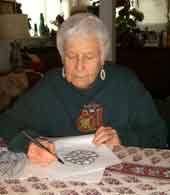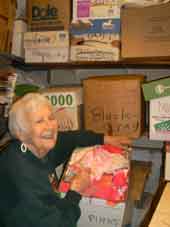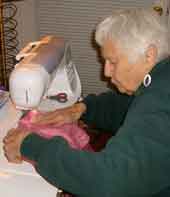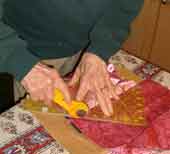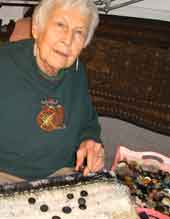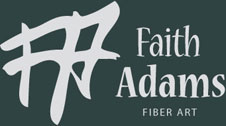The Process (written in 2010)
Sketching
Faith says an idea just pops into her head. The initial inspiration might be verbal, graphic, an experience, or a concept. She starts developing the idea with ball-point pen on whatever paper she has handy.
Not wanting to let a good idea get away, she is ready wherever she is to jot it down.
Materials
Cardboard cartons full of remnants of fabric—sorted by color—cover a whole wall in Faith's storeroom. All the yarns, buttons, beads, plant materials, jewelry, knick-knacks and whatever else she uses for embellishment take up an equal amount of space.
Much of the inspiration for making her art comes directly from these materials and the process of picking them out. Sometimes her bed is covered with pieces of cloth laid out to begin the piecing stage.
Cutting and Sewing
Cutting pieces of cloth and sewing them together is an iterative task.
In a typical grid-based piece, the first cuts are rough, the pieces are often strips, and the first sewing task is to put these small scraps together. She may use paper templates, bargello technique, or other tricks. The result is a unit bigger than she wants for the grid.
Using a circular cutter, she trims off the excess from the first piecings.
After playing with these pieced squares to realize the design and get the color relationships she wants, she sews them together into larger units. There is more trimming and more sewing, until the full design is assembled.
Each piece gets a backing fabric and batting (a "stuffing" layer).
Applying the outside borders comes after the hand sewing.
Quilting and Embellishing
The next stages require hand sewing.
Quilting, as distinguished from piecing, refers to stitching through the layers in patterns that add another dimension to the design.
"Embellishments" are the things Faith sews on to the pieced and quilted work. Naturally, she goes to the storeroom for more inspiration. Many of her most effective embellishments originally came from rummage and garage sales.
Picking out the individual items is a creative, spontaneous process. She has used everything from origami to small rocks. Novelty braids and trims are among her favorites. Perhaps more than anything else, Faith uses beads.
Adapting to Blindness
Both machine and hand sewing have become difficult lately because her eyesight is failing. However, she can knit and apply beads by touch. She is doing a series of pieces with knitted backgrounds.
